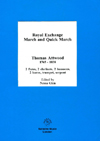
BHB Harmoniemusik Editions
available for purchase directly from Sarastro PressRoyal Exchange March & Quick March by Thomas Attwood (1765 - 1838)
Edited by Nessa Glen, 2006; Sarastro Music (SAR 0132)
2 flutes, 2 clarinets, 2 bassoons, 2 horns, trumpet, serpentExcerpts from accompanying notes and commentary
by Nessa Glenn:“Throughout his life, Attwood was the recipient of royal patronage. After a spell as a Royal Chorister, he was sent to Naples to extend his musical studies (1783 – 1785). From Naples, he traveled to Vienna where he became one of the best – and closest – students of Mozart. He returned to London after February 1787 and gradually settled into his role as a composer and music teacher. He became music teacher to the Duchess of York from December 1791. From 1792 he composed the music for more than thirty operas and plays in London. He also became teacher to the Princess of Wales from April 1795 and in 1796 he became organist of St Paul's Cathedral and composer to the Chapel Royal. After about 1803, he concentrated more and more on choral and religious compositions. Attwood was one of the original members of the Philharmonic Society in 1813, and was one of the directors from 1816-20 and 1824-32. He was a Professor at the Royal Academy of Music from its foundation in 1823. He was a close friend of composers like Mendelssohn and his pupils included Cipriani Potter. He did not copy Mozart's style but the importance of his teacher is in Attwood's attention to harmony . . . .
There were a substantial number of marches in score for the volunteer regiments during the periods of the French Revolution (1789 – 1801) and the Napoleonic period (1801 – 1815). The volunteer regiments were essentially raised to defend the beaches in case of invasion. These marches were not only the main one played by each of these regiments for marches and when they were together in their periodic training camps but they were also probably souvenirs to be purchased by the parents, relatives or sweethearts of the volunteers. Attwood's marches were composed in 1803 (registered at Stationer's Hall on 17 September). After a number of military victories, Napoleon had become First Consul for Life in 1802. In May 1803 England declared war on France and Napoleon was building up a large army camp of over 100,000 men near Calais with the intention of invading England . It was against the increasing tension that Attwood was commissioned to write these marches for the Royal Exchange Volunteers. . . .” by Nessa Glenn
Royal Exchange March: Maestoso; Quick March: Allegretto
“These two marches are amongst the finest composed during the period of military activity 1789-1815. Because the parts are only one page, the Sarastro Edition will include horn in F parts in the basic price.” Jon Gillespie
 to see the opening pages
to see the opening pages of the score
Piccolo Press : ITEA Historical Instrument Section : The Tigers Shout Band : Harmoniemusik : Links